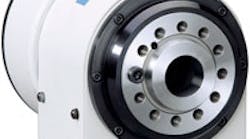The standard DD100 rotary package uses direct-drive, all-digital servo control and can be used with most any machine, though Hardinge emphasizes it is most productive when installed as a true fourth-axis.
The Hardinge DD100 direct-drive Super-Precision ® rotary table is a high-speed parts positioner with ± 3 arc-sec accuracy and 4 arc-sec repeatability that the developer calls “smart technology in a small footprint.” The developer particularly emphasizes the unit’s applicability for precision processing, as for parts supplied to aerospace and medical equipment OEMs.
The DD100 direct-drive high-speed positioner also works well for drill-and-tap and laser processing, as it’s capable of spindle speeds up to 4,200 deg/sec and up to 600 rpm continuous rotation — more than ten times faster than a gear-driven indexer, Hardinge Workholding Division asserts.
The DD100 direct-drive positioner is offered in three models for rotary tables up to a 305-mm diameter.
The Hardinge A2-4 spindle nose accepts standard 5C tooling, when used with a collet closer, for precision gripping of various part shapes, sizes and materials. 5C gripping options include collets, expanding collets, step chucks for larger part diameters, jaw chucks, and fixture plates.
Hardinge direct-drive rotary tables are characterized by simple design — a housing, bearings, an encoder, and a spindle — meaning there are fewer parts and no gears to wear.
A rare earth, permanent-magnet DC torque motor wraps around the spindle and operates with a programmed one-to-one gear ratio. The encoder is mounted directly to the spindle to provide super-precision position feedback. Hardinge’s direct-drive technology has been demonstrated as an efficient way to convert electrical energy directly into mechanical motion. The cross-roller spindle bearing is permanently lubricated, and because the direct-drive torque motor has no mechanical gearing there is no backlash. With no backlash, the table is capable of bi-directional movement with no need to compensate for backlash error. Hardinge guarantees its systems deliver a maximum runout of two ten-thousandths total indicator reading.
The standard DD100 rotary package employs the Hardinge direct-drive all-digital servo control, which can be used with most machine centers, though it most productive application is as a fourth-axis. This involves linking the unit directly to the machine so that it operates together with the other axes. According to Hardinge, its direct-drive technology “complements today’s machines that have faster axis travel and is compatible with ‘look-ahead’ programming when integrated as a fourth axis to the machine. These units are ideal for large part runs on a dedicated machine producing a family of similar parts.”
The “best feature” of this rotary table is its longevity, according to the developer. Because it is a gearless design it needs no periodic adjustments to offset backlash, nor lubrication or oil changes, all of which would risk undermining a system’s positioning accuracy. None, however, are a concern for operators of the DD100 positioner.






